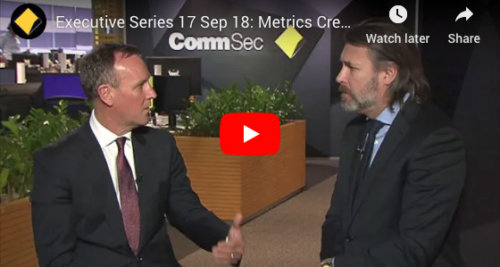Livewire: Reliable income amid the dividend cuts
So far in 2020, investors have seen circa $26b worth of dividend income disappear. For some investors, the loss of income is no great concern, but for investors that rely on that income, dividend cuts can have a material impact on lifestyles. Andrew Lockhart, Managing Director of Metrics Credit Partners, explains that unlike equity-holders, companies have a legal obligation to make payments to debt-holders, and failure to do so can have serious consequences. That’s why so many companies chose to undertake dilutionary capital raisings in March and April.
In this video and transcript, Andrew explains why credit is an attractive source of income in times of volatility, how they’ve adjusted their portfolio and lending to suit the new environment, and he discusses the level of activity they’re seeing in credit markets.
Edited Transcript
Where should investors be looking for income, given the cuts we’ve seen to dividends on the ASX?
It’s quite clear that companies will need to restore their balance sheets, restore their liquidity buffers. Given the uncertainty of future projected earnings, it’s not unreasonable that companies have been more cautious or restricted their dividend payments to investors. Unfortunately, you’ve also seen material declines in share prices combined with now lower dividend payments flowing through to investors. I think our asset class does provide that alternative for investors. You’ve got stability of capital through the debt part of the capital structure. You’re not exposed to the significant market volatility of the equity asset class.
Given companies have entered contractual arrangements, they’re obviously obligated to make those interest and fee payments to us as a lender. I think that’s an attractive way. There are other asset classes, but obviously our asset class is something I’m very familiar with and comfortable speaking to. In our asset class, the continuity of income flows and distributions to investors is likely to continue.
Do you expect distributions on corporate debt to be affected by COVID-19?
The impact to us and our funds has been felt as a result of reductions to the floating base rate. At the moment, you’ve got BBSW (Bank Bill Swap Rate) that’s actually now pricing inside the RBA cash rate. That has an impact on the total quantum of income, but certainly there are other aspects associated with it. Some companies looking to retain and preserve cash are deferring the payment of cash interest – extending out the date at which interest is due and payable. Under our facilities, a borrower can elect when they pay interest between, say, 30 days to 190 days. Some borrowers want to extend the cash payment date as a means to do that.
Overall, given our portfolio and our funds are well-diversified across a hundred-odd individual borrowers, you’ve got borrowers that are paying cash and interest obligations on an ongoing basis. Some of the borrowers, industries and companies that we lend to are not all adversely impacted as a result of the virus and lockdown arrangements. It’s a little bit unique in certain industries and specific to certain companies, but I don’t believe it will impact the overall quantum or our ability to pay cash distributions to our investors.
Are corporates a riskier investment these days then?
It’s interesting. A lot of people hear things like global credit or high yield credit and assume that the market is homogenous. Certainly in the Australian market, I think we benefit from standard lender protections, covenants, security, and controls that restrict the risk. Now, it’s important for investors to always understand, where do you sit in the capital structure? The asset class investors invest in for growth in capital is the equity asset class. So shareholders are buying equities in companies expecting growth in earnings to deliver upside capital gains and value.
They invest in the debt part of the capital structure to lower that risk of loss. From our perspective, what we always look at is the quantum of equity in the capital structure provides the buffer for the risk of any potential loss to us as a lender. Having appropriately structured terms, conditions, covenants and controls are means to mitigate risk. Certainly in parts of the market, the banks are quite clearly on record as indicating the potential risk around increasing bad and doubtful debts. Those bad and doubtful debt increases for the banks are likely to be caused as a result of increased exposure to a broad range of SMEs and also to the consumer sector, as a result of potential rising unemployment levels.
If shares in corporations have gone down, should the prices of corporate loans go down as well due to the increased risk?
No, it doesn’t work that way. Effectively, what ends up happening is you may have a temporary reduction in the value of a company. For instance, there are companies that we have negotiated amendments or waivers to their covenants over the last couple of months because their covenants are structured off earnings. as a result of the impact of the virus and how that’s impacted company earnings, those companies have asked us to amend or waive the testing of a covenant. similarly, some of those companies have then turned around within short order and completed material equity raisings.
While the value of the company may have gone lower, the value of equity at risk has actually increased in cases where companies have undertaken equity raisings. And as we’ve sort of seen, you’re seeing a material number of companies come to market and undertake deeply dilutionary equity raisings, effectively destroying value for existing shareholders. But that additional equity is being raised to increase liquidity buffers, and restore balance sheets, to assist companies to get through this period of time. Every dollar of equity raised, or every dividend not paid to a shareholder, reduces the risk of loss to us as a lender.
Those sorts of things actually mitigate the risk of loss. But you’ve got to remember too, where we sit in the capital structure means that equity can go to zero in value before we as a lender have lost one cent in value. From a true risk of impairment, equity value has to be zero and the value of the enterprise has to break into the debt value before you have actually crystallised a loss.
There’s been a fairly well publicised disconnect between the value of certain private assets, for example, infrastructure and unlisted property, compared to their publicly traded equivalents. Have you observed any similar phenomenon in private credit?
I think it’s interesting. At the end of it, the equity asset class will always have some degree of subjectivity as to the value. Investors will have different views around forward forecast of earnings and different views as to the appropriate growth rate and valuation that attaches to those forward earnings. In the debt part of the capital structure, it’s a contractual obligation. A company enters into an arrangement to borrow money from us, so they’re contractually obligated to pay the interest, pay the fees and pay the principal on maturity. Failure to do that, or a breach of covenant, may result in enforcement and insolvency action.
Companies are incentivised through insolvency laws to ensure that they adhere to their contractual obligations. We’ve not seen that large disconnect. Obviously, in certain public markets, you’ve seen a material disconnect. In offshore markets, you’re seeing the ratings agencies indicate that some sub-investment grade and high yield debt in offshore markets are likely to be exposed to increasing levels of risk of loss and default. But in the Australian market context, we’re not seeing that. The actions that the government has taken has been supportive of certain industries that have gone through difficult times.
For us as a lender, it’s about the industries and sectors that you tend to avoid that are means to ensure that you’re protecting the capital value of your investors’ portfolios. There are a range of industries that we would say are subject to greater levels of cyclicality or structural decline that were unattractive industries to lend to. A number of those industries, unfortunately, had been the ones that have been most impacted as a result of a spread of the virus and how that’s impacted businesses. We’ve seen it through the tourism sector, we’ve seen it through education, student accommodation, airlines, retail, hospitality, flowing through into retail property trusts and the like in terms of impacts on their business models.
For us, as a lender, it’s important to think, “Okay, do we have a continuation of alignment between the interests of debt and equity? And are shareholders and management incentivised to perform and the company perform?” They might be going through a more difficult period at this point in time. And it’s important for us as a lender to be constructive in that process and not force insolvency events in times of crisis. It’s important to ensure that our investors’ capital is preserved, but ensuring that equity and shareholders are equally committed to the retention of value.
Have you seen lending slow down?
We completed a number of transactions over the last couple of months. In our market, it tends to be that the origination, negotiation, structuring and execution of a transaction may take many months. They’re not simple processes where you’re buying and selling over an exchange. We believe it’s important to honour the commitments and obligations that we have to borrowers, that we had negotiated and indicated commitments of approval. So those commitments we have closed.
So, between the period of early February to the end of April, we’ve completed in excess of half a billion dollars of transactions, but they were transactions that were in progress through that period of time. Some of those included funding for an ASX listed company. We completed a number of property related transactions, and we’ve seen through those commitments, but certainly for us to deploy new capital in the current environment, unless it was an extremely attractive return for the risk, we’ve taken the view that market conditions were uncertain. And we wanted to see a little bit of the way in which market conditions might play out.
Certainly, it is throwing up some interesting opportunities for us, but I also think a lot of borrowers are reluctant to come to market seeking to raise funding in times where market conditions are more volatile. Obviously, from a lender’s perspective, where there’s market degrees of uncertainty, the terms and conditions tighten up. Market liquidity tightens up and reduces, which means that for a lender, you tend to find that the terms and conditions become more restrictive and become more favourable to you as a lender. And the absence and withdrawal of capital means that pricing tends to go higher. As a result of that, we remain open and keen to participate and find new opportunities to lend. But we’re also wanting to ensure that our investors’ capital is well protected.
What are some of the key ratios and numbers that you look at when you’re assessing the ability of a borrower to repay a debt?
Look, I think the standard is always looking at balance sheet protection mechanisms. So, issues around controlling the level of leverage that a company may have, or the loan to valuation against a property. But you’re also interested in ensuring proper debt serviceability. So appropriate interest cover and debt service covenants would usually apply.
In the last couple of months, as business conditions have been materially impacted, and demand for companies have been materially impacted, and revenues have declined, as a lender, your focus is purely on liquidity management. So that’s about understanding the level of cash that companies have on balance sheet, their access to committed but undrawn credit facilities, the way in which management might respond to that, in the form of reductions to their cost base, and understanding how many months of cash burn those businesses can sustain.
So liquidity analysis is very important, but as we move beyond this and we see businesses start to re-establish, we’re also then concerned as to understand what is the likely increased level of leverage that the companies may have incurred through this shutdown period, and what is the likely trajectory of earnings growth over time? So from our perspective, what we think we’ll end up having is a situation where we’ll get beyond this, companies will start to go back and recommence operations. The level of debt might be higher as they’ve depleted their liquidity balances over a period of time. And in certain industries, there’ll be a slower return to normality in terms of earnings. So we’re looking at potentially slightly higher levels of leverage and lower earnings growth over a period of time, before we start to see further de-leveraging of the companies in various sectors.
How has your positioning changed due to COVID-19 disruptions?
It’s interesting. We have gone into this period with probably around 35 to 40% of our total portfolio exposed to commercial real estate. Majority of that is in short-term development financing. Obviously we’ve seen a continuation through this cycle of activity in that sector. So the construction sector was allowed to continue through the shutdown period. We were obviously concerned that may have in fact slowed activity on different sites. We’ve obviously been working with our borrowers to understand how that’s performing.
It’s been interesting for us. A number of our clients have completed projects during this period of time and settled those projects without concern, without seeing any elevated risk of settlement default. Equally, we’ve also seen across a number of our clients, a continuation of sales that have occurred at or above the valuation price that we’ve extended the financing to them on. So in that regard, we’ve seen a good performance across our commercial real estate exposures.
We didn’t have any retail REIT or commercial office REIT exposure. So the majority of exposures are in development financing, predominantly in Sydney and in Melbourne, a little bit in Perth and a little bit in Brisbane. And other parts of our commercial real estate exposure was to directed towards industrial and predominantly logistics sector, industrial sites.
Across our broader part of our portfolio. We’re in a very good position. There are a number of sectors there that I mentioned earlier, be it tourism, discretionary retail, airlines, education, retail property and the like, that have been materially impacted, where we have no exposure at all. So from that perspective, I think we’re in a good position, but certainly as we go through this period of time, it’s been important to work closely with management and companies and understand how they’re performing, how they’re seeing, and how they’re responding to the market conditions. And ensuring that when we can assist them constructively through this period of time, be in a position to assist as businesses start to re-establish their operations and hopefully start to generate good solid earnings in the future.
Have you seen any defaults?
Across our portfolios, we’re in a very good position. We don’t have any borrowers that are in breach of financial covenants. We don’t have borrowers that are in default. We have no bad and doubtful debts. In fact, our portfolio is entirely up to date in terms of interest and principal payments. So our performance across our funds and the companies that we’ve lent to has been very strong. Having said that, there are companies that are doing it tough, and they will need and require assistance from lenders to work through that period of time. From our perspective, we will do that in the ordinary course just to work with businesses and management and shareholders to ensure the sustainability of those businesses as people would expect. But apart from the more notable collapse of Virgin, we’re not aware of companies in the industries and groups that we’ve been involved in that have defaulted.
Livewire – 29 May 2020
Disclaimer
This video is issued by the Trust Company (RE Services) Limited ABN 45 003 278 831 AFSL 235 150 (Perpetual) as responsible entity of each of the MCP Income Opportunities Trust ARSN 631 320 628 (MOT) and MCP Master Income Trust ARSN 620 465 090 (MXT) and has been prepared by Metrics Credit Partners Pty Ltd ABN 27 150 646 996 AFSL 416146 (Metrics) as the investment manager of MOT and MXT.
The information provided in this video is of a general nature and for information purposes only and has been prepared without taking into account your objectives, financial situation or needs. The information provided in this video does not constitute investment advice or any recommendation to acquire units in MOT or MXT, or accounting, legal or tax advice. Before making an investment decision in respect of MOT or MXT, you should consider the current product disclosure statement (PDS) of each of MOT and MXT available at www.asx.com.au and MOT’s and MXT’s other periodic and continuous disclosure announcements lodged with the ASX, which are also available at www.asx.com.au, and consider whether an investment in MOT or MXT is appropriate given your objectives, financial situation or needs. If you require advice that takes into account your personal circumstances, you should consult a licensed or authorised financial adviser.
Forward looking statements, opinions and estimates provided in this video are based on assumptions and contingencies which are subject to change without notice and should not be relied upon as an indication of the future performance. Persons should rely solely upon their own investigations in respect of the subject matter discussed in this video. Past performance is not a reliable indicator of future performance. The target cash return and target total return is only a target and may not be achieved. Payment of a quarterly distribution is a target only and Perpetual reserves the right to amend the distribution policy.
Neither Perpetual or Metrics guarantees repayment of capital or any particular rate of return from MOT or MXT. An investment in MOT or MXT is not a deposit with, nor another liability of Metrics or Perpetual nor any of their respective related bodies corporates, associates or employees. Investment in MOT or MXT is subject to investment risks, including possible delays in repayment and loss of income and capital invested. Neither Perpetual or Metrics gives any representation or warranty as to the currency, reliability, completeness or accuracy of the information contained in this video. All opinions and estimates included in this video constitute judgments of Metrics as at the date of video creation and are subject to change without notice.
Other News
Metrics Innovate Reconciliation Action Plan
We are proud to share our second Reconciliation Action Plan (RAP), reaffirming our commitment to truth, healing and unity. We…
Metrics response to ASIC’s report on Advancing Australia’s Evolving Capital Markets
Attributable to Metrics Group CEO and Managing Partner, Andrew Lockhart: Metrics Credit Partners (“Metrics”) welcomes ASIC’s roadmap to promote strong,…
INSIGHTS
MCP Income Opportunities Trust (MOT) lists on ASX
Sydney, 29 April 2019: The Trust Company (RE Services) Limited (ABN 45 003 278 831) (Responsible Entity) is the responsible…
MCP Master Income Trust wins Lonsec Listed Fund Award
The award came a year after MXT was listed on the Australian Securities Exchange






